Wednesday, October 18, 2006
Monday, October 16, 2006
A timeline history
Friday, October 13, 2006
Future consoles
 Xbox 360 is the first console to take advantage of the new high definition standard. All games made for the console will run in this new widescreen graphics since the first home 3D games in 95.
Xbox 360 is the first console to take advantage of the new high definition standard. All games made for the console will run in this new widescreen graphics since the first home 3D games in 95.
Even those without a HD screen will notice a considerable step up in graphical process for the games they play on Xbox 360. However, graphics are only one of the areas of gaming that the extra power of Xbox 360 will revolutionise.
The main difference between Xbox 360 and other next generation consoles is the fact that it is designed to be a completely connected experience. Xbox Live on the 360 improves that experience with enhanced, made in the original Xbox, offers the Xbox 360 further benefits. Music can be downloaded to the system's hard drive and played as a custom soundtrack for G'S or the console can simply be used as an 'amplifier' for any media users want to plug into it
wireless receiver, the Xbox 360 will even link to networks and talk directly with home computers.
Thursday, October 12, 2006
T.I.G.A.
 Tiga is a trade assosiation which looks after the game industry by representing commercial business intrests from europe and around the world, there are 150 studios what do this in he UK alone and a total of more than 2,000 from around the world.
Tiga consists of 113 members of which over 90 are independant and are responsable for their own studio some even up to 10 studios in the country, each employs game technitions e.t.c.
Tiga has relations with many relations including dti ukti and more.
The UK development stores produce more than 30% of the G revinue from USA and Japan.
T.I.G.A. is amung the top 5 G rating and G classification in the world and help to get a lot of "doggy" games of the shelfes and especialy close down the black market with the help of the trading standard athurity.
Tiga is a trade assosiation which looks after the game industry by representing commercial business intrests from europe and around the world, there are 150 studios what do this in he UK alone and a total of more than 2,000 from around the world.
Tiga consists of 113 members of which over 90 are independant and are responsable for their own studio some even up to 10 studios in the country, each employs game technitions e.t.c.
Tiga has relations with many relations including dti ukti and more.
The UK development stores produce more than 30% of the G revinue from USA and Japan.
T.I.G.A. is amung the top 5 G rating and G classification in the world and help to get a lot of "doggy" games of the shelfes and especialy close down the black market with the help of the trading standard athurity.
Developers
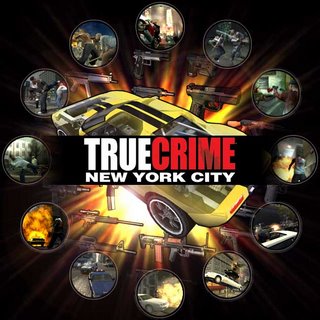 Third party developers
Video G developers fall into one of three categories: third-party developers, in-house developers, and independents. Developers usually employ a staff of programmers, G designers, artists, sound engineers, producers and testers.
usually called upon by a video G publisher to develop a title for one or more systems.
Its common for a developer to have several teams working on different titles for different publishers.
third-party developers tend to be smaller and comprised of a single, close team.
one cancelled G can be bad to adeveloper. Because many of the smaller development companies last only a few years or months. noe false move and the entire business can be wiped out because the person who was paying for the G to be developed had withdrawed his contract/ amd or is not happy with the level of service he is receiving.
In house
Many video G publishers also have large in-house development teams, or in-house developers.
Third party developers
Video G developers fall into one of three categories: third-party developers, in-house developers, and independents. Developers usually employ a staff of programmers, G designers, artists, sound engineers, producers and testers.
usually called upon by a video G publisher to develop a title for one or more systems.
Its common for a developer to have several teams working on different titles for different publishers.
third-party developers tend to be smaller and comprised of a single, close team.
one cancelled G can be bad to adeveloper. Because many of the smaller development companies last only a few years or months. noe false move and the entire business can be wiped out because the person who was paying for the G to be developed had withdrawed his contract/ amd or is not happy with the level of service he is receiving.
In house
Many video G publishers also have large in-house development teams, or in-house developers.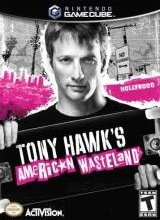 they can number from a few to the dozens. In the case of MMORPG'S, they can number in the hundreds.
tend to have greater freedom as to design and content of a G than do third-party developers.
publishers tend to be more forgiving of their own development teams going over budget and missing deadlines, e.g. Neversoft the developer of Tony Hawks, Activision which also helped to make Tony Hawks. and Luxoflux who helped to make streets of LA.
Independant
they can number from a few to the dozens. In the case of MMORPG'S, they can number in the hundreds.
tend to have greater freedom as to design and content of a G than do third-party developers.
publishers tend to be more forgiving of their own development teams going over budget and missing deadlines, e.g. Neversoft the developer of Tony Hawks, Activision which also helped to make Tony Hawks. and Luxoflux who helped to make streets of LA.
Independant
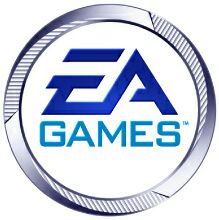 are typically small software developers that self-publish their G'S, often relying on the Internet and word of mouth for publicity. Without the huge marketing budgets of mainstream publishers, their products never get as much recognition or popular acclaim as those of larger publishers.they are free to explore
are typically small software developers that self-publish their G'S, often relying on the Internet and word of mouth for publicity. Without the huge marketing budgets of mainstream publishers, their products never get as much recognition or popular acclaim as those of larger publishers.they are free to explore  experimental themes and styles of GP
experimental themes and styles of GP
Monday, October 09, 2006
ELSPA
 The Entertainment and Leisure Software Publishers Association (ELSPA)
The ELSPA helps to clasify a good game from a bad game and weather it is suitable for public consumption.
It also helps parents and adults decide if it is suitable for their children.
ELSPA also helps provent piracy from orupting the local game industry around the world, by doing this the can stop ilegal rings of mass producing games being sold into the black market for a fraction of the recomended retail price (RRP)
ELPSA also belives that piracy costs around 3 billion pounds every year from lost profits and royalties.
ELSPA also helps first time publishers get h go ahead to publish their game and achive the status able to sell their game on the open market.
The Entertainment and Leisure Software Publishers Association (ELSPA)
The ELSPA helps to clasify a good game from a bad game and weather it is suitable for public consumption.
It also helps parents and adults decide if it is suitable for their children.
ELSPA also helps provent piracy from orupting the local game industry around the world, by doing this the can stop ilegal rings of mass producing games being sold into the black market for a fraction of the recomended retail price (RRP)
ELPSA also belives that piracy costs around 3 billion pounds every year from lost profits and royalties.
ELSPA also helps first time publishers get h go ahead to publish their game and achive the status able to sell their game on the open market.
The complete history of game consoles and controlers (part 3)
 PS*2 controller packaged into a case similar of the NES controller, Maybe it's a sign of things to come - that the current consoles and controlers are getting too complex and things need to get simplified a bit.
In this tiny package, are all the features and buttons available on the PS*2 console - right down to the twin clickable analog thumb sticks.
PS*2 controller packaged into a case similar of the NES controller, Maybe it's a sign of things to come - that the current consoles and controlers are getting too complex and things need to get simplified a bit.
In this tiny package, are all the features and buttons available on the PS*2 console - right down to the twin clickable analog thumb sticks.
 The original American design of the Xbox console and controller was deemed to be too large for the Japanese market, so Microsoft hired a design firm to create a smaller version of the Xbo*x controller specifically for the Japanese launch of the Xbo*x.
The functionality of the controller is identical, but some of the buttons had to be relocated to make the controller smaller, though the console was not changed anywhere around the world. The new button locations were even less intuitive than the original locations, but it turned out that those buttons were rarely used in-gam*e.
The original American design of the Xbox console and controller was deemed to be too large for the Japanese market, so Microsoft hired a design firm to create a smaller version of the Xbo*x controller specifically for the Japanese launch of the Xbo*x.
The functionality of the controller is identical, but some of the buttons had to be relocated to make the controller smaller, though the console was not changed anywhere around the world. The new button locations were even less intuitive than the original locations, but it turned out that those buttons were rarely used in-gam*e.
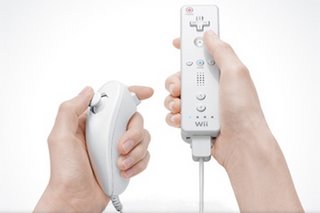 The nintend*o we coming soon!
The nintend*o we coming soon!
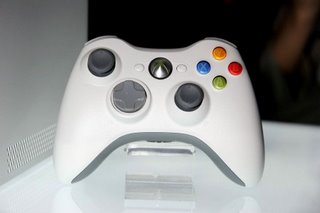 The spherical logo/button in the center of the controller is used to access the Xbox 360 user interface and can also be used to turn the Xbo*x 360 on or off. There are four lights around the button to indicate which player the controller is.
The G cube is simple sleak and afordable defenitly one of the best consoles to buy from the market, and definatly the best from nintend*o. Because of its cube size of 6" by 6"
The spherical logo/button in the center of the controller is used to access the Xbox 360 user interface and can also be used to turn the Xbo*x 360 on or off. There are four lights around the button to indicate which player the controller is.
The G cube is simple sleak and afordable defenitly one of the best consoles to buy from the market, and definatly the best from nintend*o. Because of its cube size of 6" by 6"
The complete history of game consoles and controlers (part 2)
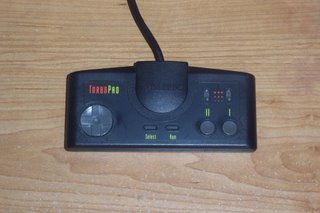 first home console to claim to be 16 bits. Well, other than having a slightly more modern style, the TurboGrafx-16 controller seems to be pretty much like the Nintendo Entertainment System controller.
The only change is the two turbo switches. These switches enable or disable slow and rapid autofire functions to the [1] and [2] action buttons.
first home console to claim to be 16 bits. Well, other than having a slightly more modern style, the TurboGrafx-16 controller seems to be pretty much like the Nintendo Entertainment System controller.
The only change is the two turbo switches. These switches enable or disable slow and rapid autofire functions to the [1] and [2] action buttons.
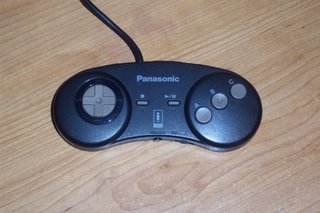 This controller has two shoulder buttons and two center buttons like on the Super Nintendo controller, and a directional pad and face buttons like on the Genesis controller. Oddly, though, the center buttons are labelled X and P instead of the otherwise almost universal select and start.
As the 3DO was intended to be a multimedia machine, the controlle also features video/audio playback controls labelled on the controller itself. The center buttons are stop and play/pause while the directional pad itself has labels for fast forward, reverse, skip forward and back. (The later Sony Playstation also seems to have adopted similar multimedia designations for it's controller.) In keeping with the multimedia theme, the controller also has a headphone jack built into it, and a volume knob.
This controller has two shoulder buttons and two center buttons like on the Super Nintendo controller, and a directional pad and face buttons like on the Genesis controller. Oddly, though, the center buttons are labelled X and P instead of the otherwise almost universal select and start.
As the 3DO was intended to be a multimedia machine, the controlle also features video/audio playback controls labelled on the controller itself. The center buttons are stop and play/pause while the directional pad itself has labels for fast forward, reverse, skip forward and back. (The later Sony Playstation also seems to have adopted similar multimedia designations for it's controller.) In keeping with the multimedia theme, the controller also has a headphone jack built into it, and a volume knob.
 At some point Nintendo suddenly terminated the project, infuriating Sony. Sony vowed to take revenge and developed their own game console.
The only significant alterations to the design are the addition of two additional shoulder buttons, and handles to make the controller more comfortable to hold. Because games would now be in 3D, the additional shoulder buttons were originally intended for the purpose of allowing players to move in or out along that extra 3rd dimension.
At some point Nintendo suddenly terminated the project, infuriating Sony. Sony vowed to take revenge and developed their own game console.
The only significant alterations to the design are the addition of two additional shoulder buttons, and handles to make the controller more comfortable to hold. Because games would now be in 3D, the additional shoulder buttons were originally intended for the purpose of allowing players to move in or out along that extra 3rd dimension.
 The Jaguar was Atari's last venture into the console market. And if there was ever an odd blending of two dissimilar controllers, this would probably be it.
Instead of following in the footsteps of their previous console, the Jaguar controller seems to be a mix of their older Atari 5200 controller and the Sega Genesis controller.
By this point in time, the 8-directional control pad was used instead. An analog stick might have fit well with the Jaguar's 3D capabilities, They wanted to introduce analog control but didn't know how well it would be recieved. Would game developers still want the traditional 8-direction control pad or would they switch to analog?
The Jaguar was Atari's last venture into the console market. And if there was ever an odd blending of two dissimilar controllers, this would probably be it.
Instead of following in the footsteps of their previous console, the Jaguar controller seems to be a mix of their older Atari 5200 controller and the Sega Genesis controller.
By this point in time, the 8-directional control pad was used instead. An analog stick might have fit well with the Jaguar's 3D capabilities, They wanted to introduce analog control but didn't know how well it would be recieved. Would game developers still want the traditional 8-direction control pad or would they switch to analog?
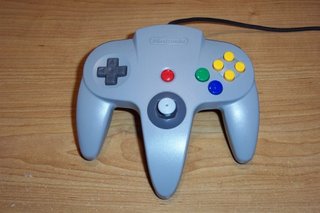 The design of the Nintendo 64 controller is likely the result of these questions. Nintendo came up with a 3 pronged solution. Hold the controller by the two outer handles for digital control, or hold it by the middle and right handles for analog control. The fact that they put the analog thumb stick in the center of the controller suggests that even they had doubts that analog would catch on.
The design of the Nintendo 64 controller is likely the result of these questions. Nintendo came up with a 3 pronged solution. Hold the controller by the two outer handles for digital control, or hold it by the middle and right handles for analog control. The fact that they put the analog thumb stick in the center of the controller suggests that even they had doubts that analog would catch on.
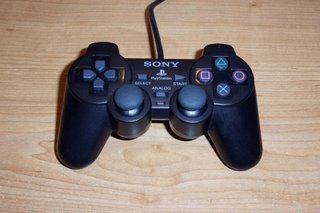 On the whole, not many games make use of the PS2 controller's analog buttons because they still feel very digital. most of these are reflected inside of the console and show there potential in that era.
On the whole, not many games make use of the PS2 controller's analog buttons because they still feel very digital. most of these are reflected inside of the console and show there potential in that era.
The complete history of game consoles and controlers (part 1)
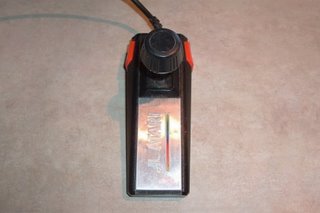 Intellivision interactive television. At least, that may have been the original concept idea behind the system.
They also designed the controller in a very untraditional way. It's more like a TV remote control of the time than a traditional game controller.
Aside from two buttons on each side of the controller, it also features a numeric keypad which is meant to allow a more advanced selection from the player. Each game also came with cards that can be inserted into the keypad, to display game-specific designations for the 12 keypad buttons.
Intellivision interactive television. At least, that may have been the original concept idea behind the system.
They also designed the controller in a very untraditional way. It's more like a TV remote control of the time than a traditional game controller.
Aside from two buttons on each side of the controller, it also features a numeric keypad which is meant to allow a more advanced selection from the player. Each game also came with cards that can be inserted into the keypad, to display game-specific designations for the 12 keypad buttons.
 The Odyssey 2 controller seems to be more or less inspired by the Atari 2600 controller. It looks similar, but in actual use it's quite different. The metal joystick moves differently and has more travel. More travel also means a slower response time.
To allow for more games, the Odyssey 2 also featured a keyboard right on the console. This allowed for personalised gameplay (name entry) and more complex input games.
The Odyssey 2 controller seems to be more or less inspired by the Atari 2600 controller. It looks similar, but in actual use it's quite different. The metal joystick moves differently and has more travel. More travel also means a slower response time.
To allow for more games, the Odyssey 2 also featured a keyboard right on the console. This allowed for personalised gameplay (name entry) and more complex input games.
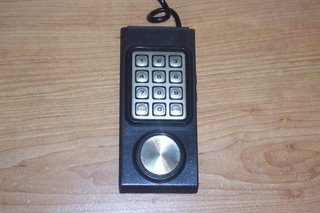 After the Intellivision came out, Atari may have started getting worried and set out to create a system to counter it. The controller was basically designed to have everything A joystick, a keypad, 4 action buttons and it was the first controller to feature start, pause and reset buttons.
The trouble is, nobody actually liked the controller. The joystick, although similar looking to the Atari 2600 stick is analog, but is not self-centering. Also, in an effort to keep the controller compact, the internal for the analog joystick was designed with sliding "guides" that turn the analog on or off.
After the Intellivision came out, Atari may have started getting worried and set out to create a system to counter it. The controller was basically designed to have everything A joystick, a keypad, 4 action buttons and it was the first controller to feature start, pause and reset buttons.
The trouble is, nobody actually liked the controller. The joystick, although similar looking to the Atari 2600 stick is analog, but is not self-centering. Also, in an effort to keep the controller compact, the internal for the analog joystick was designed with sliding "guides" that turn the analog on or off.
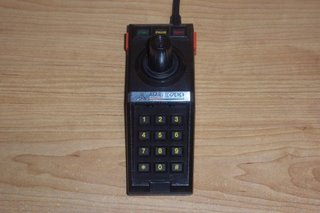 After the Atari 5200's lukewarm reception, Atari went back to the drawing board and tried again. The Atari 7800 was to take the best features of both the Atari 2600 and 5200 and also compete against both the ColecoVision and Intellivision.
Because most people found the Atari 5200 controller confusing and difficult to use, the Atari 7800 was designed to a much simpler controller, which consists of a digital joystick and action buttons on both sides. Some of this also revolves around the fact that the Atari 7800 could also play Atari 2600 games, which generally used just a basic joystick and one button.
After the Atari 5200's lukewarm reception, Atari went back to the drawing board and tried again. The Atari 7800 was to take the best features of both the Atari 2600 and 5200 and also compete against both the ColecoVision and Intellivision.
Because most people found the Atari 5200 controller confusing and difficult to use, the Atari 7800 was designed to a much simpler controller, which consists of a digital joystick and action buttons on both sides. Some of this also revolves around the fact that the Atari 7800 could also play Atari 2600 games, which generally used just a basic joystick and one button.
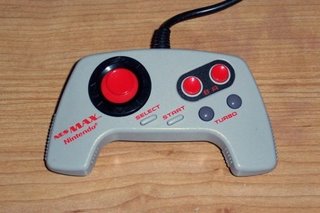 Somehow, this controller from the 8-bit era has the evolutionary beginnings of features that would be found much later in the 32 and 64-bit era. It has the beginnings of the now familar handles, and very curiously, it also has a 360 degree thumb stick instead of the usual cross-shaped directional pad.
I'm not sure how much of an impact this controller had on subsequent generations because it wasn't as widespread as the regular NES controller. It may have been long forgotten by the time the 32/64-bit generation came along.
Somehow, this controller from the 8-bit era has the evolutionary beginnings of features that would be found much later in the 32 and 64-bit era. It has the beginnings of the now familar handles, and very curiously, it also has a 360 degree thumb stick instead of the usual cross-shaped directional pad.
I'm not sure how much of an impact this controller had on subsequent generations because it wasn't as widespread as the regular NES controller. It may have been long forgotten by the time the 32/64-bit generation came along.
